Lainey’s Latest: Art Los Angeles Contemporary
It was an above average Thursday at Grand Central, the heat had been turned back on ending the dark ages of puffer jackets, scarves, and beanies in the office and, on top of that, it was beautiful day in Santa Ana. Doing my usual work: checking emails, making promotional buttons, and preparing for the day’s staff meeting, Director John Spiak came rushing down the hallway to inform me and my coworkers of Art Los Angeles Contemporary, an event starting that afternoon and lasting through the weekend. After telling us everything we should know about the event, he concluded with a VIP pass that could be used that evening, and someone should take it, immediately. After little deliberation, and a lot of selfishness on my end, I took it and ran.
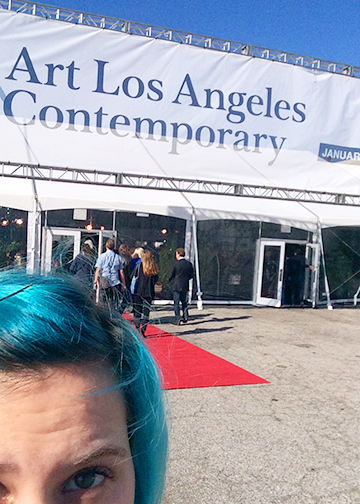
My obligatory selfie outside of Arts Los Angeles Contemporary.
Upon entering Art Los Angeles Contemporary, you were drawn to a flashing white light on your left hand side. I mean, I knew this was the VIP event, but paparazzi already? Not quite. Honor Fraser put their best foot forward with a solo exhibition of Victoria Fu’s colorful, virtual pieces, and placed her white, neon piece ??!!?! right at the door. At first, I was very confused, if not underwhelmed by it, but upon leaving, I realized it was a literal premonition of what was to come and I should have not taken it lightly. With over 60 galleries participating from all over the globe, many artists’ themes hit close to home, while others took a lighter more aesthetic approach. Some galleries chose to stay relevant by representing the big league contemporary artists of each generation. Alden Projects showcased Jenny Holzer’s “Inflammatory Essays” from 1979-1982, whereas Cherry and Martin displayed a video piece by Brian Bress. Millenials were well covered as well, with Ever Gold [Projects] displaying large photographs by Petra Collins, a 24 year old photographer filling her shots with teen angst and the female gaze reminiscent of Olivia Bee’s work a decade prior. Then there is Kanye Griffin Corcoran aiming for the wide cult following of David Lynch with a solo exhibition of his drawings and paintings that mirror his dark and peculiar films. Aside from an appeal to every age market and their niches, the major themes of the show this year mirrored the worries that have come up in our current state as a nation: gender and sexuality, race, and socioeconomic status.

“??!!?!” by Victoria Fu represented by Honor Fraser.
![Colorful photographs by Petra Collins from her "24 Hour Psycho" Exhibition with Ever Gold [Projects]](http://www.grandcentralartcenter.com/wp-content/uploads/2017/02/PetraCollins.jpg)
Part of Petra Collins’ “24 Hour Psycho” exhibition shown by Ever Gold [Projects].
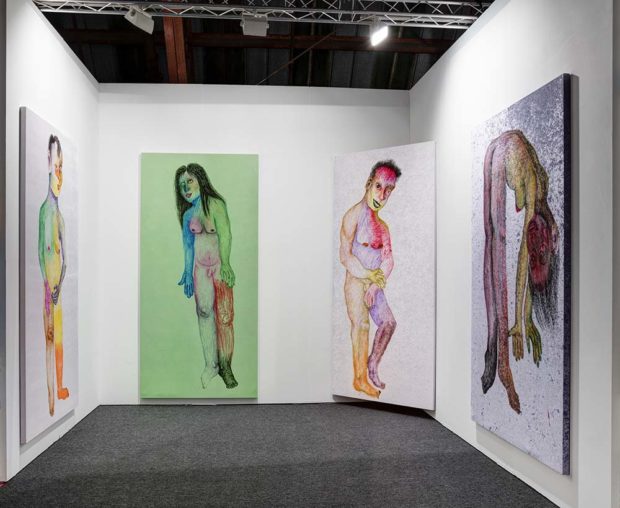
Ann Hirsch’s portraits. Photograph courtesy of Steve Turner Gallery.
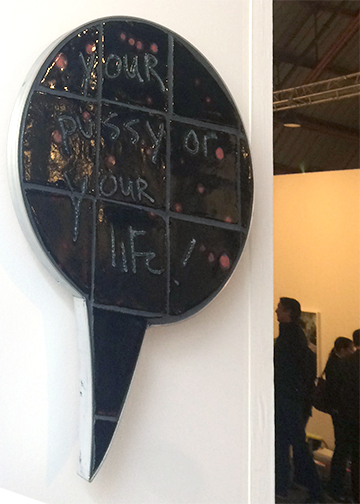
“Your Pussy or Your Life!” by Liz Craft in Jenny’s booth.
Surprisingly, for a year about the advancement of race relations and unity, not many galleries touched on the topic, granted it does have a fine line. The most successful representation was through Clint Roenisch, out of Toronto, Canada, showcasing the works of Marvin Luvualu Antonio. As you turn the corner to reach their booth, you are stopped by, yet another, neon sign stating “Race in Progress” immediately denoting a cultural uprising is about to happen. As you enter the space, the first work you see is a mirror reflecting your image with the words “How Many Years a Slave”, Antonio’s Pink Matter. As a white female, this threw my white privilege right into my face as I thought of all the conveniences I have and how many people have suffered or died for my $5 t-shirt and Apple iPhone. Marvin Luvualu Antonio’s work stopped me dead in my tracks in the best possible way bringing me back to Grand Central Art Center’s roots as a socially conscious gallery. On the other hand, Club Pro merged pop culture and black culture and I was not sure if it was meant to be satire of America’s perception of black culture. Club Pro’s booth was converted into Water Cooler Talk, a modified cubicle or office space, by Devin Troy Strother, which was, according to the artist, “on the border of being extremely commercial and experimental”. The bulletin board behind the desk displayed photographs and cut outs of Michael Jackson, LL Cool J, and Star Wars advertisements, the colors in the space hyper pigmented, water coolers filled with juice resembling imagery from the film “Idiocracy”, and the labels around the office involving the controversial “N-word”.
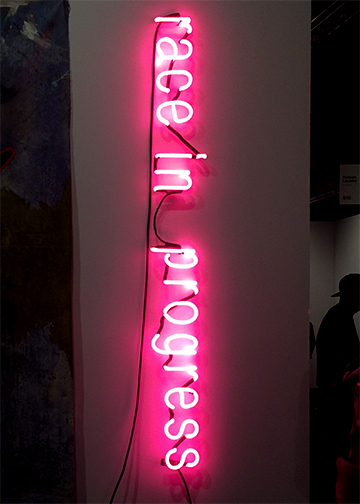
Marvin Luvualu Antonio’s “Race In Progress” neon sign as part of his “Pink Matter” exhibition with Clint Roenisch Gallery.
On the socioeconomic end of Art Los Angeles Contemporary, Gallery Luisotti commented on the discarded remains of consumer culture. Gallery Luisotti exhibited different photographers with a common theme of desolation or emptiness, where Christina Fernandez and John Divola focused on the items left behind. Fernandez’s diptych, Coldwell and Couch, shows a luscious, green hillside with a secluded community of homes, assumingly for sale, and a couch in the distance. Then, in the second photograph, the same couch looks worse for wear surrounded by dried brush. The degradation in the span of time is reminiscent of the state humanity and nature, once bountiful then dried up and abandoned when the resources are exhausted. Divola’s Isolated Houses depicts homes alone in barren desert scenery. The homes are art themselves, brightly painted against the neutral dirt and photographed forefront to baby blue skies or fuchsia sunsets. The quiet scenes cause the assumption of abandonment, stuck in time.
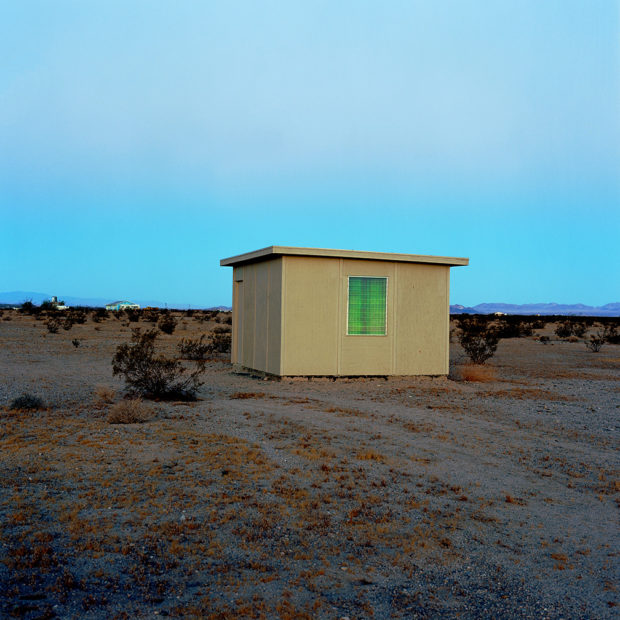
“N34 °09.974’ W115 °48.890’” by John Divola as part of his Isolated Houses series. Courtesy of Gallery Luisotti.
When my brain was spinning from all the thoughts invoked by these pieces, I decided to sit down and do a second, purely aesthetic, round. But who was I kidding? As soon as I stepped into, what I thought would be a mixed media pop art exhibition with an ode to the classic Nintendo character Mario, One and J. Gallery’s elongated booth spanned to the collective strife of Seoul based artists. Kyunghwan Kwon’s untitled white drawings on black paper depicted billowing clouds of smoke and silent night scenes, while Jung Lee played with light trails in breath taking locations and titled the work “This Is The End”, and Yunho Kim photographed dilapidated homes emphasizing their more attractive or interesting features, like the vegetation in “Bassia Plants”. Farther into the Barker Hanger, Gallery Exit, from Hong Kong, represented Chris HUEN Sin Kan’s oil painted genre art, with brushwork and pale neutral tones mimicking the look of watercolor. Gallery Exit’s booth was the aesthetic breath of fresh air I was searching for decompressing from the overly saturated, in your face, pieces shown throughout the fair. Plus their agent, Anthony Tao, was equally as calming with a kind attitude, genuinely wanting to speak on the art at the fair, not just seeing the money in everyone walking by, and his excitement for his first venture in Los Angeles.
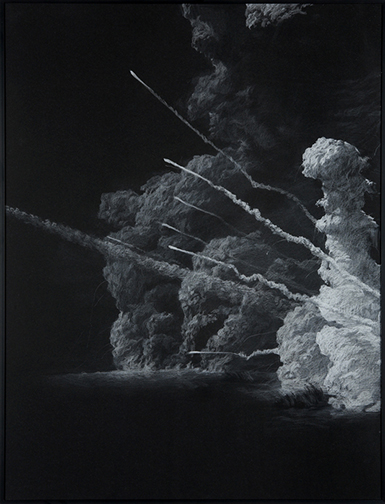
Kwon Kyunghwan’s “Untitled 26”. Courtesy of One and J. Gallery.
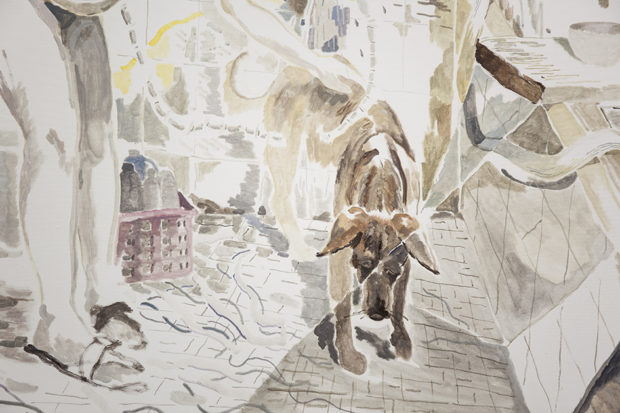
Chris HUEN Sin Kan’s “Bathing 2”. Courtesy of Gallery EXIT.
As my first large event while working with an institution, Art Los Angeles Contemporary surely did not disappoint with the art shown and the extravagant atmosphere. Though my written experiences barely skim the surface of the four day event, it was not an exhibition to miss, and, hopefully in the following years of revolution in the arts community, I will have the opportunity to return.